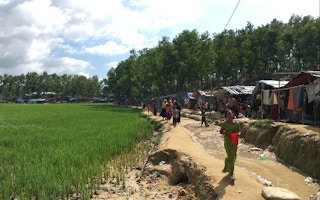Located in southeastern Bangladesh, the Balukhali-Kutupalong camp in Cox’s Bazar houses approximately 600,000 Rohingya refugees, making it the biggest refugee camp in the world.
The entire Cox’s Bazar settlement, where more than 1 million refugees currently reside, sprung two summers ago to accommodate the mass exodus of Rohingya people fleeing persecution in their homeland, Myanmar. The camps have expanded ever since, placing undue pressure on an area that was initially home to about 300,000 Rohingyas who had arrived in an earlier migration wave.
As people struggle with displacement and ensuing poverty in makeshift camps, the natural habitats that support their survival have simultaneously suffered extreme loss as surrounding forests are converted into wood fuel and lands become degraded from human use.
According to the United Nations Development Programme (UNDP), over 4,000 acres of hills and forests have been cut down to make way for temporary shelters, facilities, and cooking fuel in Cox’s Bazar. Human settlements have also disrupted the migration flows of endangered Asian elephants in the area, putting both human and animal welfare at risk.
“The latest Rohingya settlement has amplified human-elephant conflict in the area, with 13 human casualties so far. The remaining elephant habitat is also under severe pressure from uncontrolled fuelwood collection in the forest,” said Sharif A Mukul, assistant professor at the department of environmental management at Independent University Bangladesh.
Mukul, who has done work in Cox’s Bazar, told me that the refugee influx has resulted in environmental degradation both within the refugee camps and the surrounding areas.
“Without environmental sustainability, it is difficult to accommodate a large number of refugees in the long run as a healthy environment, which is also impacted by their actions, is vital for their survival,” he said.
The situation is similar in humanitarian crises elsewhere. Although one person is forcibly displaced every two seconds, the repercussions of large-scale migration on the environment are rarely reported on, according to Italian photographer Gabriele Cecconi.
In his online photo series The Wretched of the Earth, the photographer highlights the tragic bond between the plight of refugees and the environmental crisis in Cox’s Bazar. Cecconi depicts the refugees’ perilous living conditions in a camp where overpopulation, land degradation and pollution have affected public health and safety.
In the Middle East, the Syrian refugee crisis has also led to “an environmental catastrophe” in host countries such as Turkey, Jordan and Lebanon, as more people escaping violence and hardship back home resettle in ecologically-sensitive or dense urban areas that are unable to cope with the mass influx of people.
The bond between humans and their environment
It was not until I volunteered at a refugee settlement in the city of Sidon, Lebanon, for two months in 2017 that I realised how integral the environment was to the welfare of the community and how environmental priorities were largely absent from humanitarian development.
Working alongside my friend Emilie Tricarico, a fellow volunteer at Belgian-Lebanese organisation SB OverSeas, I saw how proper waste management and access to nature would improve the lives of Syrian refugee children who, despite living in an abandoned compound close to the sea, spent much of their time playing on dangerous piles of abandoned construction waste around the settlement.
Her idea to build an urban garden with the children—many of whom had grown up in the Syrian countryside—never came to fruition but her ecological thinking has stuck with me.
The capacity of non-profit organisations are often extremely stretched in humanitarian cases, especially in the face of social and legal barriers in host countries, and environmental considerations are often sidelined as necessities such as adequate food, shelter and education take precedence.
“Everybody knows the indissoluble but fragile bond between human being and his environment; during a mass migration this line is widely crossed,” said Cecconi in an interview with LensCulture. “Today we have 68 million refugees in the world, the highest number ever—and many mass migrations have to deal with the same issues.”
However, as rising sea levels, water scarcity and other climate-related disasters threaten to displace as many as one billion people by 2050, more people are paying attention to the connection between the environment and mass migration.
The environment and development disconnect
The former head of United Nations Environment Erik Solheim once described the environment as both a silent victim and driver of conflict and disaster. Vulnerable populations are highly dependent on the natural environment for their livelihoods, which puts them on a slippery slope towards the over-exploitation of natural resources.
This, in turn, places refugees living in precarious conditions in a vicious cycle, where a deteriorating environment puts them at greater risk of deprivation and disease.
For humanitarian response to be effective, environmental risks have to be assessed alongside wider assessment of immediate needs, according to the internationally recognised The Sphere Handbook: Humanitarian Charter and Minimum Standards in Humanitarian Response.
There remains a huge gap between the environmental and humanitarian sectors, which do not often work in tandem in dire situations such as the protracted conflict in Afghanistan or the aftermath of natural disasters, as in post-earthquake Haiti.
The office of environment at the United Nations High Commissioner for Refugees (UNHCR), for instance, has only 15 global staff to address environmental issues surrounding the 68.5 million UNHCR-registered people who have been forcibly displaced from their home countries due to war, persecution or violent conflict.
“Ultimately we tend to see human beings as separate from their environment and environmental protection as having a separate objective than humanitarian action,” United Nations Environment Programme’s Emilia Wahlstrom, who heads an initiative called Connecting Environment and Humanitarian Action (EHA) Connect, said in a phone interview.
“From what we see now with climate change, however, we cannot anymore afford to think of ourselves as separate from the natural environment,” she said.
Wahlstrom, a programme officer in the Joint UNEP and Office for the Coordination of Humanitarian Affairs (OCHA) unit added that one of the reasons why environmental concerns have rarely been taken into account in humanitarian situations is because both sectors operate on different timeframes.
Humanitarian actors respond to urgent crises counted in months or years, but environmental changes happen more slowly and are much more complex.
“Environmental impacts are also not perceived as a life-saving issue, whereas food, water and shelter is something that everyone realises we need right now,” said Wahlstrom. “But you can’t have good humanitarian action if you do not consider the natural constraints of where you operate.”
With the intense rate of migration happening around the world, two-thirds of refugees are now displaced for at least five years, while one in five remain displaced for more than 20 years.
Long-term humanitarian mechanisms that include an environmental and ecological approach in conflict and disaster-driven migration are hence all the more important, especially as fragile environments can raise the risk of further conflict and increase the severity of natural disasters.
Bridging the gap
In a bid to bring about more resilient emergency management systems and mitigate the environmental impacts of humanitarian operations, EHA Connect links environmental and humanitarian actors and ensures that environmental data and expertise is applied within the humanitarian sector.
“We do not want to fall into blaming humanitarians because they are providing essential aid and lifesaving expertise,” explained Wahlstrom. “We need to work together to consider more sustainable solutions that also make sense economically. We cannot just continue trucking water in year after year, because that is just not sustainable.”
Resources offered via EHA Connect include a quick screening tool that informs humanitarian actors of the environmental risks associated with their activity, such as flooding or land degradation.
Wahlstrom added that the local and refugee populations need to be part of peace-building and sustainable development efforts, while efforts to bridge the environmental and humanitarian gap should feature local and traditional knowledge from the community.
“Due to the cross-border movements, there might be tension between the host population and refugees in terms of natural resources and the permanence of solutions,” she said, recognising that there may be reluctance from the host country in implementing long-term, sustainable solutions. Renewable energy farms, for example, may not be an option when migration flows are large perceived as temporary.
Lebanon, for instance, does not provide legal status or rights to work for Syrian refugees, and uses the term ‘displaced persons’ instead of refugees to avoid the permanency of their stay and legal obligations towards them.
People fleeing from climate disasters are currently not protected by international law as stipulated in the Refugee Convention, spelling greater challenges for them.
“Refugees are people facing extreme hardship and have their own priorities, so in no way are we saying that they have to become environmentalists,” said Wahlstom. “It is important however, for those working to help them have a better understanding of the environmental drivers and impacts of disasters and conflict, especially as natural resources are found to be the underlying cause.”









